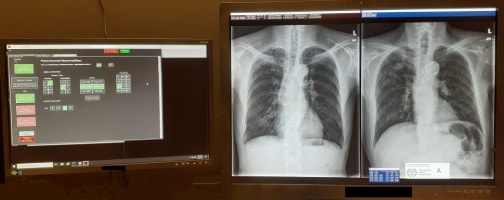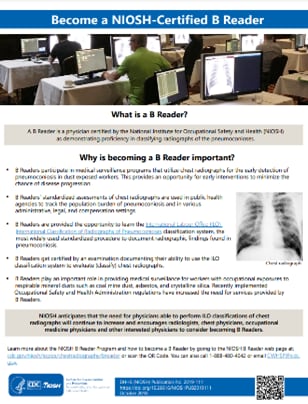Chest Radiography and B Reader Program

Photo by NIOSH
Chest radiography is an important tool for medical screening and surveillance of workers exposed to mineral dust. It is used to help:
- Identify workers with pneumoconiosis as early as possible in the course of the disease. Timely interventions to reduce or eliminate further dust exposure can lower the chances of disease progression.
- Screening alone does not make a clinical diagnosis but can identify workers who need additional evaluation and testing by their healthcare providers.
Chest radiographic images of workers exposed to dust are classified according to the International Labour Office (ILO) International Classification of Radiographs of Pneumoconioses. The ILO classification is the most widely used standardized procedure to evaluate for presence and severity of changes of pneumoconiosis in chest images. Data from classifications are used by government programs and public health officials world-wide to characterize the appearance and epidemiology of pneumoconiosis in affected populations.
The NIOSH B Reader program trains and certifies physicians in the ILO classification system. In the U.S., regulations specify roles for B Readers in classifying chest radiographic images of workers participating in health surveillance due to jobs involving exposure to mineral dusts such as coal mine dust, crystalline silica and asbestos. B Readers also perform classifications in a range of other settings, including research, legal, and evaluation for benefits.
NIOSH anticipates that the need for this important skill will continue to increase. NIOSH encourages radiologists, chest physicians, occupational medicine physicians, and other interested physicians to undergo NIOSH B Reader training and to achieve certification in image classification.
B Reader examinations are now open at the NIOSH facility in Morgantown. Call (888) 480-4042 or email CWHSP@cdc.gov to schedule your exam. B Reader examination information includes:
B Reader Exam Overview
NIOSH is administering an updated B Reader examination which is different from the previous version developed using film-based chest radiographs. The current examination uses modern digital chest radiographic images and was developed through a partnership between NIOSH and the American College of Radiology. More than fifteen experts in ILO classification from around the country contributed to developing the exam.
Lessons learned and feedback received during more than forty years of administering the B Reader Program informed the design and approach to the new exam.
The new exam has five content domains. To achieve a passing score, the examinee must have passing scores in each of the five domains:
- Multiple choice questions covering material in the self-study syllabus (new)
- Assigning a quality score to the radiograph (new)
- Determining the presence or absence of small opacities; and if small opacities are present, assigning a profusion score
- Identifying when large opacities are present
- Identifying pleural abnormalities; specifically, the presence (and side) of pleural plaques and costophrenic angle obliteration
As noted above, two of the domains are new since the previous exam. They are described in more detail below:
- Multiple choice questions testing for concepts relevant to ILO classification. Questions are drawn from the NIOSH B Reader study syllabus.
- Correct evaluation of image quality:
- Quality 1 – Good and Quality 2 – Acceptable with no technical defect likely to impair classification of the radiograph for pneumoconiosis
- Quality 3 – Acceptable, with some technical defect but still adequate for classification,
- Quality 4 – Unacceptable for classification purposes.
NIOSH recommends that those planning to take the exam use the B Reader study syllabus to learn the material covered in the exam. B Viewer software can be used to review the DICOM-format chest radiographic images contained in the study syllabus. The same software is used to administer the examination, so becoming familiar with it ahead of time might be helpful in preparing for the exam.
Being a B Reader
B Readers use their demonstrated proficiency in classifying chest radiographs to participate in research, surveillance, legal and administrative (such as compensation) programs and activities.
Physicians who classify chest radiographs for certain federal surveillance programs may be required to be B Readers. For example, NIOSH’s Coal Workers’ X-ray Surveillance Program’s governing regulations, (42 CFR 37), requires that B readers be engaged in classifying chest radiographs. Another example is the Asbestos Medical Surveillance Program (AMSP), administered by the Navy and Marine Corps Public Health Center (NMCPHC), which requires that the second reader of each radiograph be a B Reader.
Because programs using B Readers’ classifications must be able to trust that they are accurate and based solely on the appearances of chest radiographic images, B Readers must adhere to the B Reader Code of Ethics. B Readers should also recognize issues that can affect reading accuracy work in settings that follow recommended practices to ensure accurate classifications to the degree possible. B Readers providing classifications to the Black Lung Benefits Program operated by the Office of Workers’ Compensation Programs, U.S. Department of Labor, might undergo quality assurance reviews if they provide classifications that are identified as possibly inaccurate.
Maintaining B Reader Status
Readers must retest every five years to maintain their B Reader status. Testing can be done any time within the fifth year. The retest exam is currently the same as the initial certifying exam.
A reader who fails the retest must take it again and pass before the end of their five-year approval period expires in order retain their B Reader status. There is no waiting period between failing the retest and taking it again. B Readers who do not retest and pass before their expiration date will lose their certification and will not be able to provide B readings until they pass the exam.
B Reader State Medical Licensure
The NIOSH B Reader certification is a national certification. However, it is not a type of licensure to practice medicine. Certification through NIOSH’s B Reader program only indicates proficiency in classifying radiographs using the ILO system. Therefore, physicians must perform duties in accordance with medical licensure laws of States and Territories. Requirements may vary depending on the State or Territory and the nature of the work. To ensure that all medical licensure requirements of States and Territories are followed, NIOSH recommends that non-federal B Readers consult with the relevant State Boards of Medicine prior to engaging in chest image classification, including those jurisdictions where chest radiographs were performed.
List Search of B Readers
This list will be updated continuously. Listing does not imply medical licensure.
Use this search form to select the criteria for your search. Leaving the Last Name and State fields blank will produce a complete list of B Readers.
Listed by State of Residence
Successful International Examinees
Use this search form to obtain a listing of physicians from outside the United States who have demonstrated competence in applying the ILO classification by successfully completing the NIOSH B Reader examination. Leaving the Last Name field blank will produce a complete list of examinees.
Become a NIOSH-Certified B Reader Fact Sheet

NIOSH Publication No. 2019-111: Become a NIOSH-Certified B Reader (cdc.gov)
Contact Information and Filing Complaints
Please contact us if you have questions or need further information.
- Call (888) 480-4042
- Email CWHSP@cdc.gov
- Mail the Program at:
National Institute for Occupational Safety and Health
Coal Workers’ Health Surveillance Program
1000 Frederick Lane
Morgantown, WV 26508
Using a medical license to commit fraud is a violation. Complaints about a specific B Reader should be referred to the appropriate State medical licensing board. These boards are responsible for assuring competence and integrity of licensed physicians.
